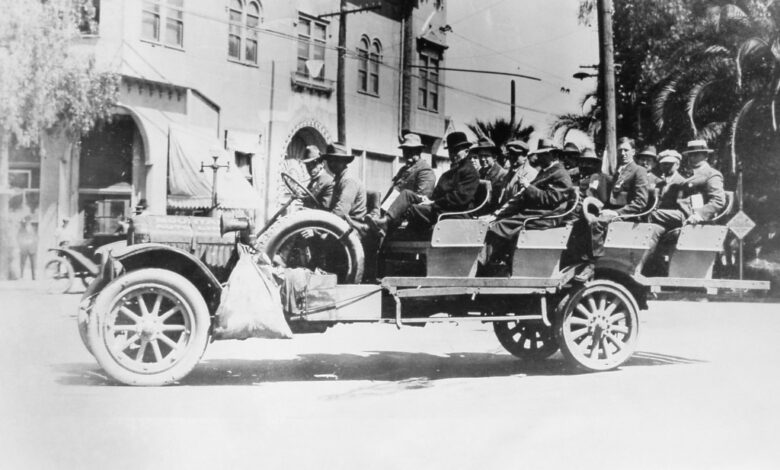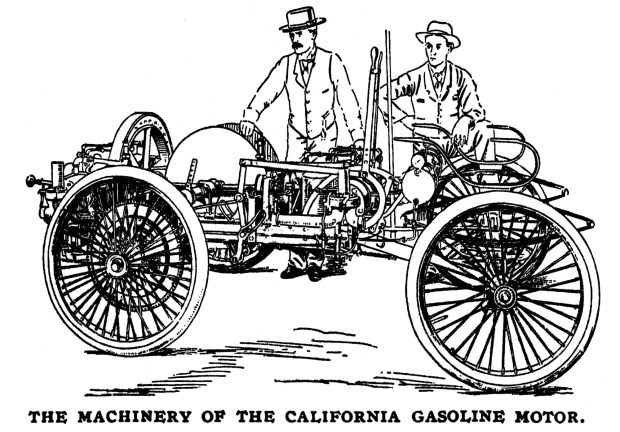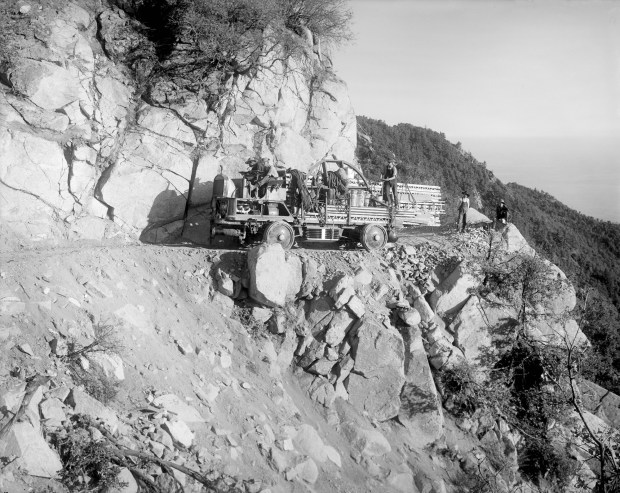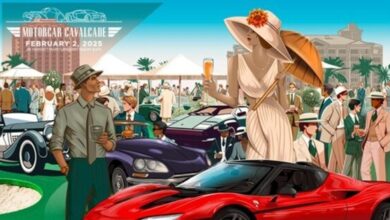How Southern California’s car culture got its start – San Bernardino Sun

Passengers aboard a Mountain Auto Stage Line coach are ready to depart from Redlands for a tour of the Rim of the World Scenic Drive in the San Bernardino Mountains, circa 1920. Rim of the World Scenic Drive is arguably the earliest scenic mountain drive in the United States. (Photo from the collection of Mark Landis)
Southern California’s famous “car culture” began in the earliest days of the automobile, and the love affair has spawned an impressive list of “firsts” in the automotive world.
The first gasoline-powered automobile in Southern California emerged from a machine shop on West Fifth Street in Los Angeles in the early morning hours of May 30, 1897. The home-built “horseless carriage” was constructed by S.D. Sturgis, for engineer J. Phillip Erie, who came up with the concept.
With eight people aboard, the automobile slowly chugged its way through Los Angeles streets, barely exceeding the speed of the pedestrians. After stopping for some minor repairs, the vehicle was driven to Erie’s home in Boyle Heights, where it was quietly retired as an unsuccessful experiment.
In early summer 1899, Mr. Cass Gaylord of Redlands was patiently awaiting the delivery of his new Haynes-Apperson two-seat automobile he ordered in January 1899. Gaylord was hoping to be the first person to own and operate a factory-built automobile in Southern California, but the delivery was somehow delayed.
On July 22, 1899, the first factory-built automobile in Southern California was delivered to Mr. S.R. Henderson of Los Angeles. Henderson’s three-wheeled “Duryea Motor Trap” was uncrated and test-driven July 25.

Gaylord’s automobile was delivered July 26, 1899, with significant damage sustained in transit. It took two weeks to repair and on August 10, 1899, Gaylord’s five-horsepower Haynes-Apperson made a noisy debut on Redlands streets.
To this day, some Redlands residents believe Gaylord’s delivery was purposely delayed so Los Angeles could claim to have the first factory-built automobile in Southern California.
Surrounded by hills and a crest of mountain ranges, Southern Californians began challenging the rugged terrain with their early automobiles. In 1901, a steam-powered automobile made the first trek out of the Los Angeles basin, and crossed the Newhall Pass into the Santa Clarita Valley.
In 1905, a White steam car driven by E.C. Sterling of Redlands became the first automobile to successfully crest the Cajon Pass in the San Bernardino Mountains. Sterling made the trip on a rugged wagon road from San Bernardino to Victorville in just 3 hours and 15 minutes.
Planning for the revolutionary 60-inch Hale telescope project on Southern California’s 5,715-foot Mount Wilson began around 1904, and in 1906, a custom-designed electric truck was built to haul large, heavy materials up the mountain road.
The truck had a gasoline engine that drove a generator, which powered electric motors at each of the four wheels. The motors could also be used for regenerative braking when going downhill.
Because of the extremely tight turns on the road, all four wheels were designed to steer the vehicle — 120 years later, these design innovations are still used in the EV/hybrid world.
The 101-mile Rim of the World Drive in the San Bernardino Mountains opened in 1915, and is arguably the earliest scenic mountain road in the United States. The drive reaches an elevation of 7,000 feet, and traverses mountain cliffs, ridges, and valleys offering spectacular vistas.

In December 1940, the Arroyo Seco Parkway (later renamed the Pasadena Freeway) was dedicated and opened to the public, becoming the first freeway in the U.S. The six-mile stretch of intersection-free roadway signaled the beginning of California’s massive freeway building program that would continue for decades.
The car culture in the U.S. created a need for “drive-in” restaurants, and the first drive-in was opened in Dallas, in 1921. The drive-in restaurants allowed customers to order food from their car or a walk-up window, and it was delivered by “carhops” for in-car dining.
Southern California was the birthplace of some of the earliest and largest drive-in restaurant chains including:
- 1936 – Bob’s Big Boy, Glendale
- 1940 – McDonald’s, San Bernardino
- 1951 – Jack In The Box, San Diego
- 1948 – Bell’s Drive-In, San Bernardino (owner Glen Bell founded Taco Bell in Downey, in 1962)
- 1956 – Carl’s Jr., Anaheim
- 1961 – Wienerschnitzel, Wilmington
- 1964 – Del Taco, Yermo
Southern California was also the birthplace of In-N-Out Burger, the first “drive-through” restaurant with a car-to-kitchen speaker system that allowed customers to stay in their vehicle.
Harry Snyder, owner of In-N-Out Burger, opened his first restaurant in Baldwin Park in 1948, and his speaker system revolutionized drive-thru service.
Drag racing began on the dry lake beds of Southern California’s Mojave Desert in the 1940s with souped up jalopies and hot rods, and it evolved into high tech, purpose-built race cars. The first sanctioned drag strip opened in 1950, using a runway at the Santa Ana Airport, now known as John Wayne Airport.
The main sanctioning body of drag racing, the National Hot Rod Association held its first race in 1953, at the Los Angeles County Fairgrounds in Pomona.
Southern California revolutionized the automobile buying experience in 1965, when a group of enterprising car dealers in Riverside came up with the idea for the first auto mall.
When the Riverside Auto Center was formed, the idea of bringing competing dealerships together in one location contradicted decades of sales practices, but the concept was so successful, it transformed the auto industry.
Southern California is also responsible for some infamous automobile firsts, like severe, unhealthy episodes of smog, caused in large part by cars. The topography of Southern California forms large basins that trap emissions, and the effects are compounded by the region’s weather.
The smog episodes became severe in the 1940s, and they led the state of California to create the nation’s first tailpipe emission standards in 1966. Automobile manufacturers had to develop new technology and equipment such as catalytic converters, and “on-board diagnostics” (“check engine” light systems) to accommodate emission requirements.
The adoption of emission controls on automobiles has dramatically reduced smog in Southern California.
Another infamous Southern California first was the first live broadcast of a police chase on Jan. 3, 1992. The lengthy pursuit ended with a shootout between police and the suspect in Garden Grove. The live pursuits became so popular that local TV channels began to preempt regular programming and cover them.
It’s been more than 120 years since the first automobile sputtered and rattled through Los Angeles, and Southern Californian’s are still in love with their vehicles. Even when faced with extreme traffic challenges across the region, the car culture of Southern California seems poised for even more automobile firsts and innovations.
Mark Landis is a freelance writer. He can be reached at Historyinca@yahoo.com.



